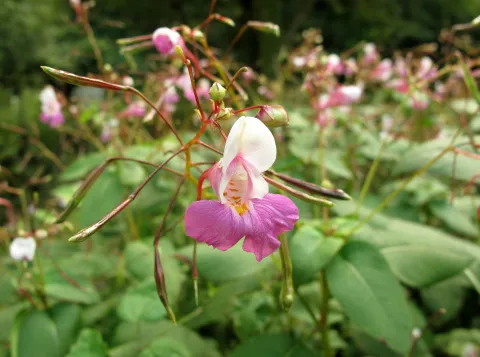"There certainly are more. You take a look at them tomorrow," she said.
I remembered in the morning, and looked out of the window as I was dressing. I saw that Josella was right. One could count over a hundred of them behind the quite small stretch visible from the window. I mentioned it at breakfast. Susan looked suprised.
"But they've been getting more all the time," she said. "Haven't you noticed?"
That’s from John Wyndham’s fantasy The Day of the Triffids when a handful of survivors are besieged by killer plants on a remote farm. And it springs to mind when I was walking in the woods today. For triffids, read Himalayan balsam, a tall blousy, slightly feeble looking flower that seems to do extremely well in our soils.
It has surged along footpaths, forestry roads, clearings cut by the local power company to protect the power lines and across abandoned fields, where it battles with bracken for supremacy. Its scientific name Impatiens glandulifera seems to sum up its restless quest for domination.
And there are more than ever this year. Like the heroes of DOTT, I periodically deploy weaponry to slash down swathes of this tall invader. Instead of a flamethrower, I use a slasher, which makes a curious thwock as it slices through the succulent but hollow stems of the balsam.
So, lots of questions – where does it come from and is it a problem? And what can be done about it? As its name more than hints at, it is a native of the Himalayas but was introduced to Britain in the mid 19th century as a garden exotic. It soon escaped and it’s easy to see how.
At this time of year, having been flowering since early August, it is now producing seed pods. Once these grow large enough, they explode, catapulting seeds several metres, thus ensuring rapid dispersal. This afternoon in mid October, I walked through a balsam thicket setting off dozens of these hair-trigger pods. The force released is so great, I could feel the string of seeds on my face and the seeds were flung several metres. My son loves popping them.

The flowers are quite pretty in a sultry, orchid sort of way. And some people tell me they produce lots of nectar so bees and other insects love them – though I see far more insects on the ivy flowers than this exotic. But the balsam does dominate. Paths that I walked in June are now impassable unless recut with the slasher. Even brambles and bracken seem cowed by the balsam’s ‘impatiens’ so less vigorous native plants are often overwhelmed.
The Himalayan balsam is particularly fond of riverbanks. Here it can fire its seeds into the flowing water and let the current take them to new
The first frost kills the lot of them and they rot and vanish with the bracken – two good reasons to enjoy winter more. This sudden disappearance isn’t a problem on the hill but can be an issue on riverbanks as they will have already driven off other native plants, so there are no root networks to hold unstable muddy banks in place – and erosion occurs.
What is being done? Some Wildlife groups organize balsam bashing parties in sensitive areas but this corner of the Brecon Beacons is a little neglected and there is no one to keep the balsam in check. I’ve seen holes in leaves and occasionally sheep will try it, but it doesn’t seem particularly attractive to native herbivores. There are, however, recipes for the using the seeds in a curry. I just have to catch them first… Perhaps we can madras our way out of this crisis.

